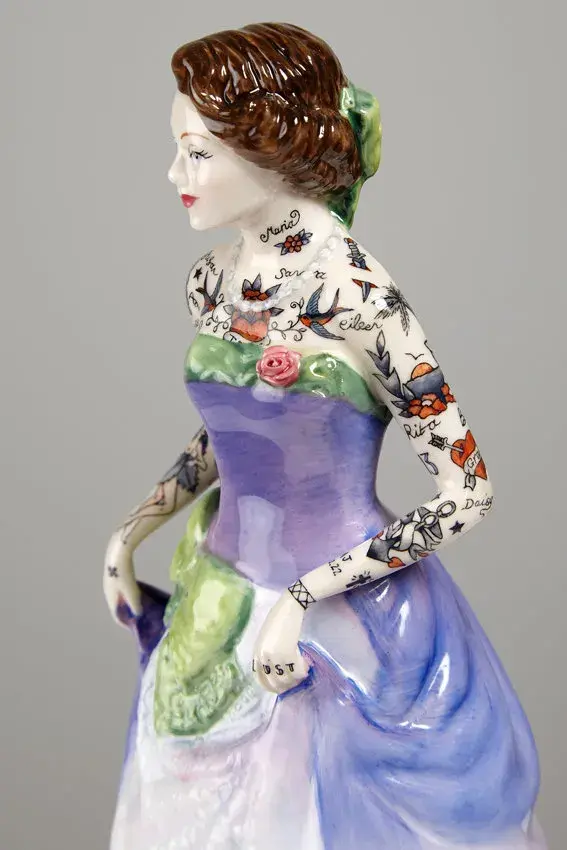The Beautiful And Gruesome Porcelain Dolls Created By Jessica Harrison
- Daniel Holland

- Jun 25, 2023
- 3 min read

I'm a little late to the party but I'm a big fan of Jessica Harrison's take on the traditional porcelain doll.
We all remember them. Maybe perched on your nan’s mantlepiece, or lined up behind the glass in your local charity shop, those prim little porcelain ladies, frozen mid-curtsy, eternally rosy-cheeked and sweet as sugar. Innocuous. Old-fashioned. Harmless.
Until artist Jessica Harrison gets hold of them.
In her series Broken, Harrison takes these mass-produced figurines, emblems of demure femininity, and transforms them into something far more unsettling. These ladies remain perfectly poised, their dainty hands still outstretched and their gowns still flowing, but their bodies tell a very different story. Some are stabbed or beheaded, others peeled apart to reveal organs that spill from their porcelain stomachs. Their expressions, however, never change. They grin politely through the gore, their tidy hairdos untouched.
Harrison isn’t out simply to shock. Her work probes the uneasy relationship between interior and exterior, what we expect to stay hidden, and what’s brought to the surface. The delicate ceramic bodies become vessels not of beauty and grace, but of viscera and vulnerability. As she puts it:
"What should be hard is soft, what should be brittle is flexible, what should be fragile is fleshy, what should be precious is broken."
It’s a clever subversion of the Victorian ideal of womanhood: all modesty, manners and manicured appearances. With scalpel-like precision, Harrison exposes the contradictions of that legacy. The result is both humorous and grotesque, a bit like watching a Jane Austen character walk calmly through a horror film.

But Broken is only part of the picture. In another of her standout series, Flash, Harrison gives her porcelain women a distinctly different makeover, this time with tattoos. Drawing on classic sailor motifs, anchors, skulls, roses, ships, she inks their pale ceramic skin with designs more commonly associated with dockyards than drawing rooms. The contrast is jarring and deliberate. Underneath the lace and petticoats lies a body marked and storied, no longer passive but expressive.

This work nods to French philosopher Michel Serres, particularly his reflections in Les Cinq Sens (The Five Senses), where he writes:
"Consciousness conceals itself in folds… when the skin tissue folds upon itself. By itself, the skin takes on consciousness… Without this folding-over, this contact of the self with itself, there would be no internal sense, no body of one's own."
For Harrison, this ‘folding’ is visualised in the tattooed skin, where inked surfaces become a record of identity, emotion, even pain. These figurines are not mute ornaments but complex canvases. Their beauty no longer lies in flawlessness, but in contrast—in the unexpected collision of image and implication.

Harrison herself describes her sculptures as exploring "the surface of the body as a mode of both looking and thinking." She isn’t reaching inward to a subconscious self, nor outward to some lofty theory. Instead, she’s moving sideways, orthogonally, across the skin, examining how the outer layer of the body can express something interior without ever truly revealing it.
Her work challenges how we experience touch and form. In place of slick conceptual detachment, Harrison insists on mess, rupture, the strange weight of stillness. Her figurines are not merely remade, they’re reimagined. They don’t perform femininity, they interrogate it.

Based in Edinburgh, Harrison earned her PhD in sculpture in 2013 with support from the Arts and Humanities Research Council. Her academic research is rich with questions of tactility, presence and mortality, themes that translate powerfully into her studio practice. With every inked forearm or disembowelled waistline, she suggests that bodies, even porcelain ones, aren’t so neat or so knowable.

And perhaps that’s the point. These aren’t just broken figurines. They’re women undone and redone, with guts on display and stories etched in ink, grinning not because they’re fine, but because they’ve survived something.

Sources
Jessica Harrison – https://www.jessicaharrison.co.uk
Michel Serres, Les Cinq Sens (The Five Senses)
Galerie L.J. – https://www.galerielj.com




























































































































Comments